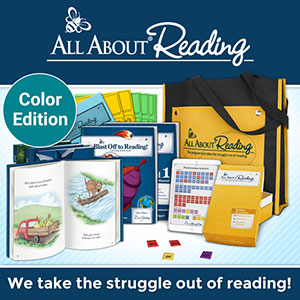Please note that this post contains affiliate links.
As I begin teaching my fourth child how to read using All About Reading, I desire to recommend AAR (and its sister program All About Spelling) wholeheartedly again.
Seven years ago, I wrote a detailed review of All About Reading Level 1: I wrote a good, detailed overview of the system. Since then I've become an even more enthusiastic fan, I've learned more about the Orton-Gillingham method of teaching phonics, and I've watched some homeschooling friends switch to using AAR with their dyslexic children to great success. I am so keen on AAR because it was designed for a severely dyslexic child who for whom it was declared he would never be able to read or spell and, in fact, would need to be institutionalized (story here), yet it's also excellently suited for average and gifted readers, and it uses visual, auditory, and tactile learning methods.
This week, as I worked with preschooler Joseph--two months shy of five years old--on AAR Level 1, I reflected to myself about how I have taught this method variously over the years, with different children, and how I teach it to my number four.
I'm busy!
I'm a highly structured homeschool parent in my heart (not always in practice) and still during the nine o'clock hour, my schedule dictates that I am supervising an 11-year-old on piano and a 9-year-old on violin, sitting between a first grader, who I'm teaching directly, and a Preschooler, who I'm teaching directly, while monitoring at my feet a two-year-old playing, and I'm usually holding the three-month-old baby. That's me being organized with our time, not even being chaotic.I can't teach the way I used to teach.
I love the AAR system--all the magnetic phonemes, the box of word cards--but at this season, I truly cannot get out all of those items. I would get them all set up, only to have to dash off and change a dirty diaper, save a toddler from climbing the bookshelf, or answer the doorbell.And, honestly, I've never done the fun activities in between lessons. I tried during the first year to cut out with scissors, get everything prepared, but for me and my family, those activities were not a good fit. However, they seem to be designed very well and for some kids, those activities will be the motivation to keep going, the spice of life in a lesson! My point is simply not to be put off if you're not a "crafty mom," as AAR works very well even without those activities.
Right now, I grab the nearest piece of paper and write out the phonemes myself. (I suggest using a dark black pen, not the pencil as I was using above. A pen is easier for an emerging reader to see.) I write out the phonemes we are reviewing, and then I write out one word at a time for reading. I space the words as much as the child needs. Above, spacing them on every other line is enough for this child right now. At least one of my children, at a beginning point, needed to look at one word on the page, or the child would get overwhelmed.
 |
| Happily jumping |
The way I have had to teach two sons so far is different than the way I taught two daughters so far. I realize it is stereotypical, but one daughter taught herself to read by age three (so she's an exception), and the other learned easily under my teaching by age four. The boys were much more wiggly and a fantastic technique I've discovered is to have my son jump on the trampoline in between reading anything. Right now, this son is sent to jump in between reaching each word. As my first son got older, his time in between jumps stretched till he was jumping in between each sentence read, then between each page read, until he really didn't need to jump any more.
I also teach in as short of lessons as the child needs. Some of my children would sit for five minutes only, others wanted to sit till we got through the whole Lesson of AAR (which can be done in a sitting, but maybe is more often done over the course of a week). Some children completed several lessons of AAR in one sitting once they became highly proficient. I go at their paces, and their paces change over the months and years until they outgrow AAR entirely. There is no strict schedule or rush.
I also give immediate feedback. All About Reading comes with a delightful little worksheet on which the child gets to put a sticker after finishing each lesson. My kids love that! But I take it one step further and for these very young children, I draw (with brightly colored pencil) a smiley face, star, heart, or the like next to the word as soon as the child has read it successfully. I do this in spelling as well . . . for all my ages of children!
If the child can't manage to read it, and needs help, then I still put the smiley face after we've completed going through it together. If the child needed to correct spelling, and then he does, I add the smiley face to the corrected word or sentence. They really seem to appreciate it, even if some are too old to admit it. A mother knows these things.






No comments:
Post a Comment